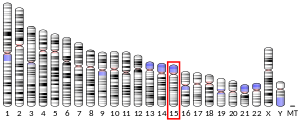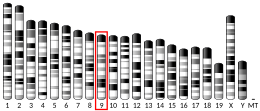Protein-coding gene in the species Homo sapiens
E3 SUMO-protein ligase PIAS1 is an enzyme that in humans is encoded by the PIAS1 gene .[ 5] [ 6] [ 7]
Function
This gene encodes a member of the mammalian PIAS [protein inhibitor of activated STAT-1 (signal transducer and activator of transcription-1)] family. This member contains a putative zinc-binding motif and a highly acidic region. It inhibits STAT1-mediated gene activation and the DNA binding activity, binds to Gu protein/RNA helicase II/DEAD box polypeptide 21, and interacts with androgen receptor (AR). It functions in testis as a nuclear receptor transcriptional coregulator and may have a role in AR initiation and maintenance of spermatogenesis.[ 7]
Interactions
PIAS1 has been shown to interact with:
References
^ a b c GRCh38: Ensembl release 89: ENSG00000033800 – Ensembl , May 2017^ a b c GRCm38: Ensembl release 89: ENSMUSG00000032405 – Ensembl , May 2017^ "Human PubMed Reference:" . National Center for Biotechnology Information, U.S. National Library of Medicine .^ "Mouse PubMed Reference:" . National Center for Biotechnology Information, U.S. National Library of Medicine .^ Liu B, Liao J, Rao X, Kushner SA, Chung CD, Chang DD, Shuai K (September 1998). "Inhibition of Stat1-mediated gene activation by PIAS1" . Proc Natl Acad Sci U S A . 95 (18): 10626– 10631. Bibcode :1998PNAS...9510626L . doi :10.1073/pnas.95.18.10626 PMC 27945 PMID 9724754 . ^ Valdez BC, Henning D, Perlaky L, Busch RK, Busch H (July 1997). "Cloning and characterization of Gu/RH-II binding protein". Biochem Biophys Res Commun . 234 (2): 335– 340. doi :10.1006/bbrc.1997.6642 . PMID 9177271 . ^ a b "Entrez Gene: PIAS1 protein inhibitor of activated STAT, 1" .^ Ling Y, Sankpal UT, Robertson AK, McNally JG, Karpova T, Robertson KD (2004). "Modification of de novo DNA methyltransferase 3a (Dnmt3a) by SUMO-1 modulates its interaction with histone deacetylases (HDACs) and its capacity to repress transcription" . Nucleic Acids Res . 32 (2): 598– 610. doi :10.1093/nar/gkh195 . PMC 373322 PMID 14752048 . ^ a b c Kahyo T, Nishida T, Yasuda H (September 2001). "Involvement of PIAS1 in the sumoylation of tumor suppressor p53" . Mol. Cell . 8 (3): 713– 8. doi :10.1016/s1097-2765(01)00349-5 PMID 11583632 . ^ Gallagher WM, Argentini M, Sierra V, Bracco L, Debussche L, Conseiller E (June 1999). "MBP1: a novel mutant p53-specific protein partner with oncogenic properties" . Oncogene . 18 (24): 3608– 16. doi :10.1038/sj.onc.1202937 PMID 10380882 . ^ Liao J, Fu Y, Shuai K (May 2000). "Distinct roles of the NH2- and COOH-terminal domains of the protein inhibitor of activated signal transducer and activator of transcription (STAT) 1 (PIAS1) in cytokine-induced PIAS1-Stat1 interaction" . Proc. Natl. Acad. Sci. U.S.A . 97 (10): 5267– 72. Bibcode :2000PNAS...97.5267L . doi :10.1073/pnas.97.10.5267 PMC 25817 PMID 10805787 . ^ a b Lee BH, Yoshimatsu K, Maeda A, Ochiai K, Morimatsu M, Araki K, Ogino M, Morikawa S, Arikawa J (December 2003). "Association of the nucleocapsid protein of the Seoul and Hantaan hantaviruses with small ubiquitin-like modifier-1-related molecules". Virus Res . 98 (1): 83– 91. doi :10.1016/j.virusres.2003.09.001 . PMID 14609633 . ^ a b Sapetschnig A, Rischitor G, Braun H, Doll A, Schergaut M, Melchior F, Suske G (October 2002). "Transcription factor Sp3 is silenced through SUMO modification by PIAS1" . EMBO J . 21 (19): 5206– 15. doi :10.1093/emboj/cdf510 . PMC 129032 PMID 12356736 .
Further reading
Tan J, Hall SH, Hamil KG, Grossman G, Petrusz P, Liao J, Shuai K, French FS (2000). "Protein inhibitor of activated STAT-1 (signal transducer and activator of transcription-1) is a nuclear receptor coregulator expressed in human testis" . Mol. Endocrinol . 14 (1): 14– 26. doi :10.1210/mend.14.1.0408 PMID 10628744 . Liao J, Fu Y, Shuai K (2000). "Distinct roles of the NH2- and COOH-terminal domains of the protein inhibitor of activated signal transducer and activator of transcription (STAT) 1 (PIAS1) in cytokine-induced PIAS1-Stat1 interaction" . Proc. Natl. Acad. Sci. U.S.A . 97 (10): 5267– 5272. Bibcode :2000PNAS...97.5267L . doi :10.1073/pnas.97.10.5267 PMC 25817 PMID 10805787 . Kotaja N, Aittomäki S, Silvennoinen O, Palvimo JJ, Jänne OA (2001). "ARIP3 (androgen receptor-interacting protein 3) and other PIAS (protein inhibitor of activated STAT) proteins differ in their ability to modulate steroid receptor-dependent transcriptional activation" . Mol. Endocrinol . 14 (12): 1986– 2000. doi :10.1210/mend.14.12.0569 PMID 11117529 . Gross M, Liu B, Tan J, French FS, Carey M, Shuai K (2001). "Distinct effects of PIAS proteins on androgen-mediated gene activation in prostate cancer cells" . Oncogene . 20 (29): 3880– 3887. doi :10.1038/sj.onc.1204489 PMID 11439351 . Liu B, Shuai K (2001). "Induction of apoptosis by protein inhibitor of activated Stat1 through c-Jun NH2-terminal kinase activation" . J. Biol. Chem . 276 (39): 36624– 36631. doi :10.1074/jbc.M101085200 PMID 11451946 . Kahyo T, Nishida T, Yasuda H (2001). "Involvement of PIAS1 in the sumoylation of tumor suppressor p53" . Mol. Cell . 8 (3): 713– 718. doi :10.1016/S1097-2765(01)00349-5 PMID 11583632 . Weiskirchen R, Moser M, Weiskirchen S, Erdel M, Dahmen S, Buettner R, Gressner AM (2001). "LIM-domain protein cysteine- and glycine-rich protein 2 (CRP2) is a novel marker of hepatic stellate cells and binding partner of the protein inhibitor of activated STAT1" . Biochem. J . 359 (Pt 3): 485– 96. doi :10.1042/0264-6021:3590485 . PMC 1222169 PMID 11672422 . Megidish T, Xu JH, Xu CW (2002). "Activation of p53 by protein inhibitor of activated Stat1 (PIAS1)" . J. Biol. Chem . 277 (10): 8255– 8259. doi :10.1074/jbc.C200001200 PMID 11788578 . Schmidt D, Müller S (2002). "Members of the PIAS family act as SUMO ligases for c-Jun and p53 and repress p53 activity" . Proc. Natl. Acad. Sci. U.S.A . 99 (5): 2872– 2877. Bibcode :2002PNAS...99.2872S . doi :10.1073/pnas.052559499 PMC 122440 PMID 11867732 . Tan JA, Hall SH, Hamil KG, Grossman G, Petrusz P, French FS (2002). "Protein inhibitors of activated STAT resemble scaffold attachment factors and function as interacting nuclear receptor coregulators" . J. Biol. Chem . 277 (19): 16993– 17001. doi :10.1074/jbc.M109217200 PMID 11877418 . Nishida T, Yasuda H (2003). "PIAS1 and PIASxalpha function as SUMO-E3 ligases toward androgen receptor and repress androgen receptor-dependent transcription" . J. Biol. Chem . 277 (44): 41311– 41317. doi :10.1074/jbc.M206741200 PMID 12177000 . Rui HL, Fan E, Zhou HM, Xu Z, Zhang Y, Lin SC (2003). "SUMO-1 modification of the C-terminal KVEKVD of Axin is required for JNK activation but has no effect on Wnt signaling" . J. Biol. Chem . 277 (45): 42981– 42986. doi :10.1074/jbc.M208099200 PMID 12223491 . Sapetschnig A, Rischitor G, Braun H, Doll A, Schergaut M, Melchior F, Suske G (2002). "Transcription factor Sp3 is silenced through SUMO modification by PIAS1" . EMBO J . 21 (19): 5206– 5215. doi :10.1093/emboj/cdf510 . PMC 129032 PMID 12356736 . Miyauchi Y, Yogosawa S, Honda R, Nishida T, Yasuda H (2003). "Sumoylation of Mdm2 by protein inhibitor of activated STAT (PIAS) and RanBP2 enzymes" . J. Biol. Chem . 277 (51): 50131– 50136. doi :10.1074/jbc.M208319200 PMID 12393906 . Ungureanu D, Vanhatupa S, Kotaja N, Yang J, Aittomaki S, Jänne OA, Palvimo JJ, Silvennoinen O (2004). "PIAS proteins promote SUMO-1 conjugation to STAT1" . Blood . 102 (9): 3311– 3313. doi :10.1182/blood-2002-12-3816 PMID 12855578 . Kadaré G, Toutant M, Formstecher E, Corvol JC, Carnaud M, Boutterin MC, Girault JA (2004). "PIAS1-mediated sumoylation of focal adhesion kinase activates its autophosphorylation" . J. Biol. Chem . 278 (48): 47434– 47440. doi :10.1074/jbc.M308562200 PMID 14500712 . Tallec LP, Kirsh O, Lecomte MC, Viengchareun S, Zennaro MC, Dejean A, Lombès M (2004). "Protein inhibitor of activated signal transducer and activator of transcription 1 interacts with the N-terminal domain of mineralocorticoid receptor and represses its transcriptional activity: implication of small ubiquitin-related modifier 1 modification" . Mol. Endocrinol . 17 (12): 2529– 2542. doi :10.1210/me.2003-0299 PMID 14500761 . Coppola D, Parikh V, Boulware D, Blanck G (2009). "Substantially reduced expression of PIAS1 is associated with colon cancer development". J Cancer Res Clin Oncol . 135 (9): 1287– 91. doi :10.1007/s00432-009-0570-z . PMID 19288270 . S2CID 20383429 .
Information related to PIAS1






